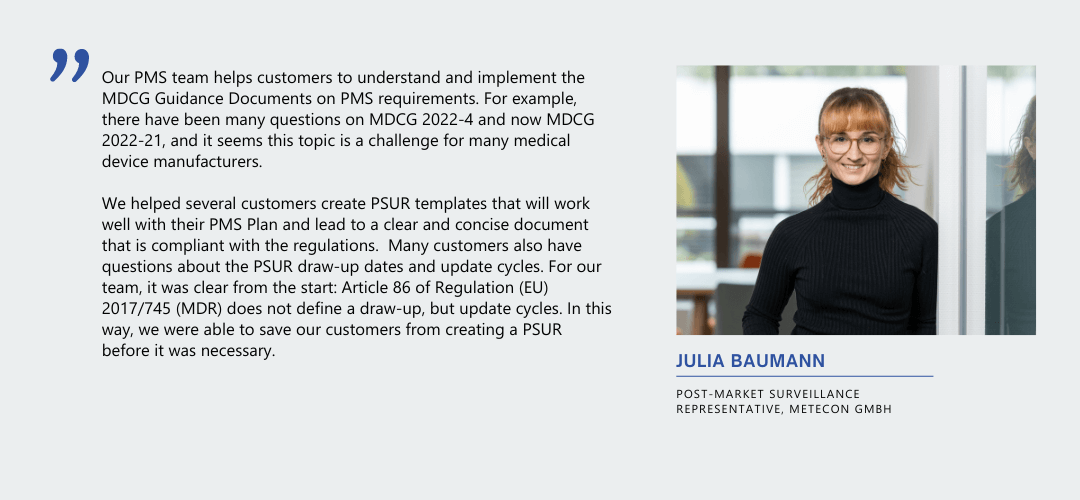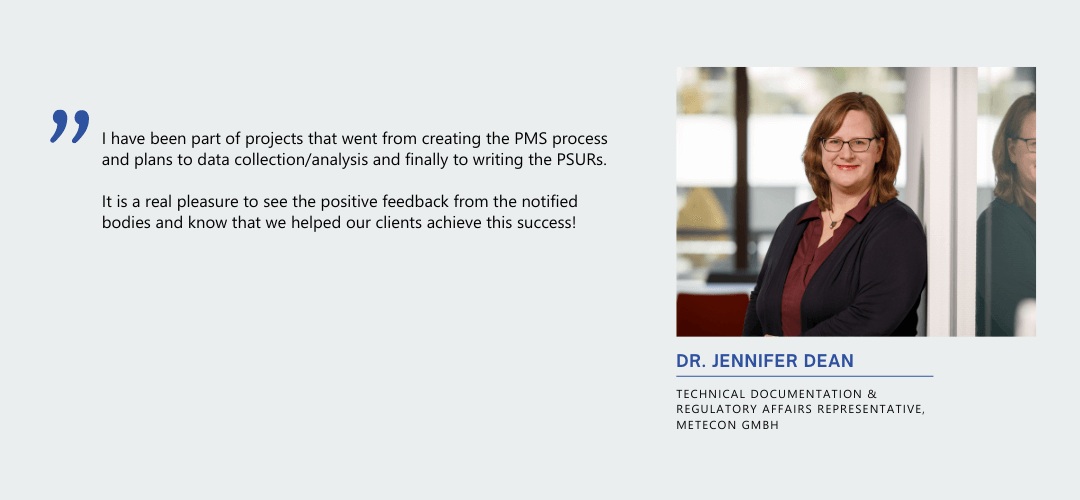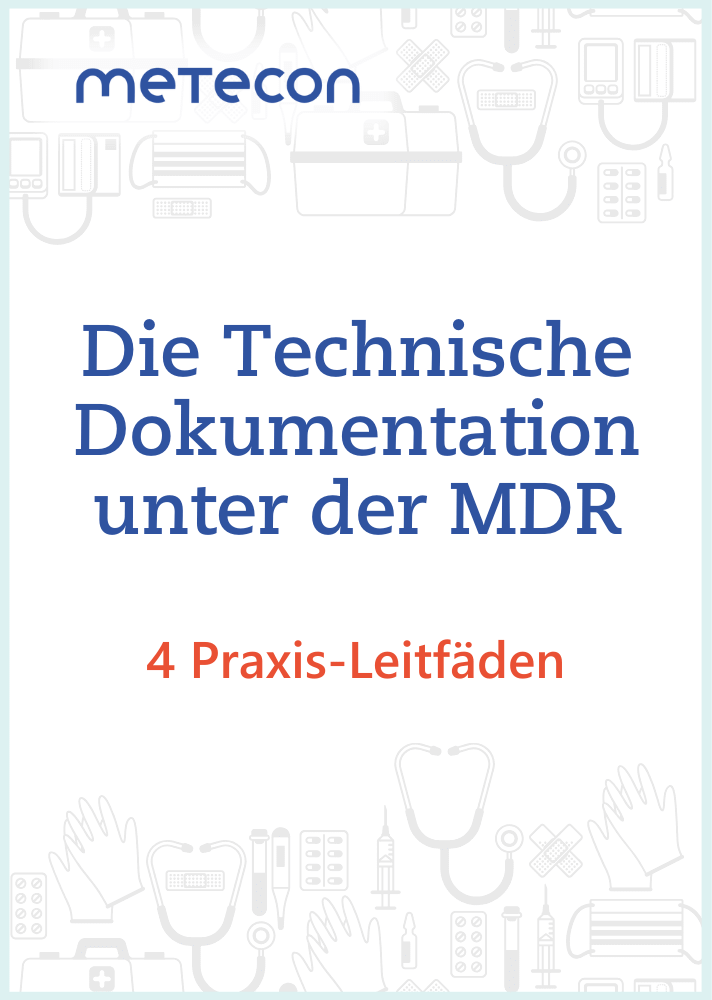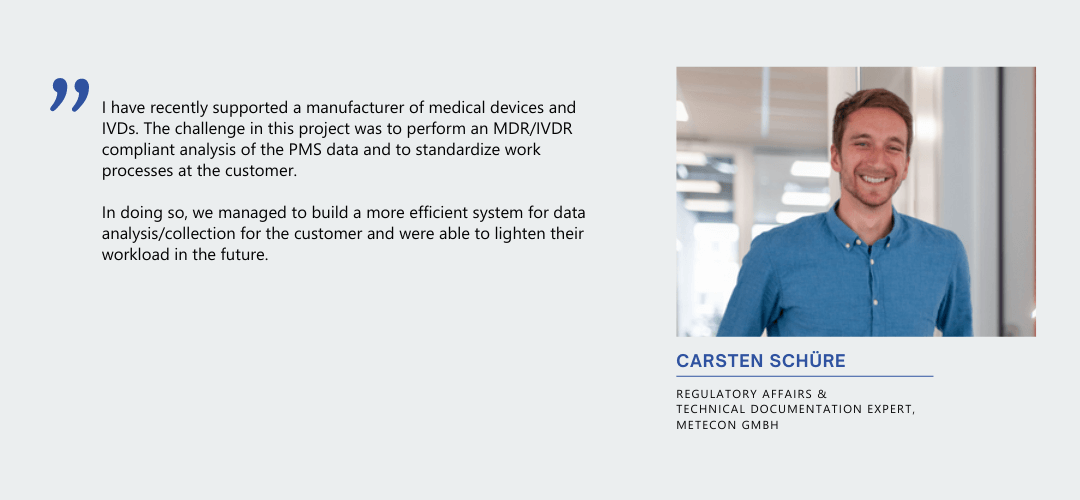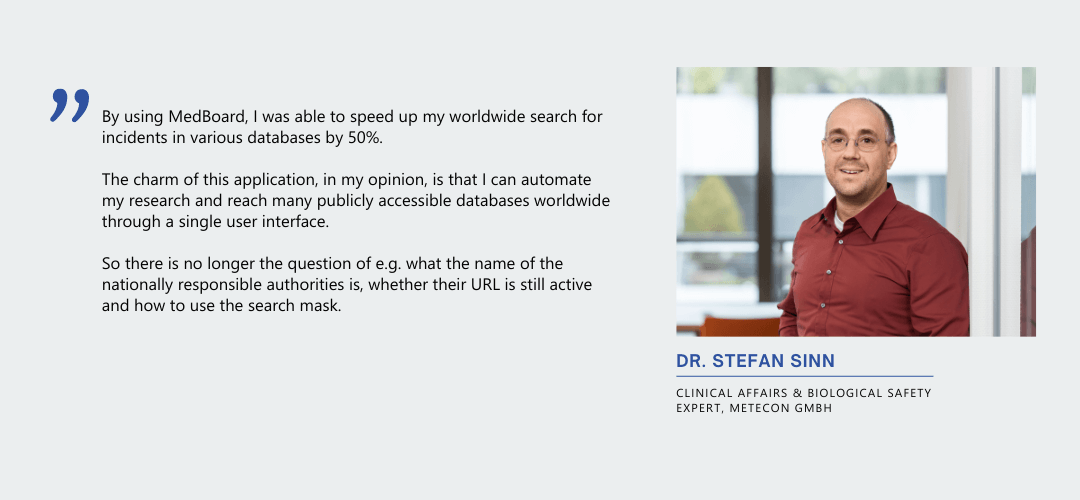As a medical device manufacturer, you are required to actively monitor the market and develop defined Post-Market Surveillance (PMS) strategies for each product or product family. This enables you to identify and address underestimated complications and issues that were not apparent prior to launch, as well as unforeseen uses of your product throughout the product lifecycle.Post-market surveillance activities can include: handling complaints; vigilance; interviewing patients, users, distributors and transporters; evaluating feedback from the hotline, social media forums to app store reviews; researching surveillance agency databases on incidents and recalls on similar products in the market; and product-specific Post-Market Clinical Follow-up (PMCF) activities. In this context, any activity that is not incident-related counts as active.Through a jointly developed strategy, you can efficiently incorporate this data into your clinical evaluation and save a lot of time and high personnel costs during the (annual) update.
Definition of post-market surveillance (PMS)
Post-Market Surveillance (PMS) refers to a systematic process by the manufacturer for post-market surveillance. How and why PMS is needed is explained in Chapter 7 "Post-market surveillance, vigilance and market surveillance" of the MDR (EU Regulation 2017/745). ISO 13485:2016 and ISO 14971:2022 also require post-market surveillance.Our services in detail
Support and consulting services on post-market surveillance (PMS), e.g. by planning proactive market observation and developing PMS processes.Creating reports required under the MDR:
Contact us to find out how we can help you plan, implement and evaluate all these reports.
- CDP - Clinical Development Plan
- CEP - Clinical Evaluation Plan
- CER - Clinical Evaluation Report
- PMS Plan/PMCF Plan
- SSCP - Summary of Safety and Clinical Performance: for class III and implantable devices
- Vigilance Report, PMCF Report, Trends (Proactive Post-Market Surveillance)
- PMS Report and Periodic Safety Update Report (PSUR) for all class IIa devices or higher.
Contact us to find out how we can help you plan, implement and evaluate all these reports.

Save your time and money with smart updates
Adapting a clinical evaluation from MDD to MDR usually involves lot of efforts. Once a good MDR-compliant foundation has been created and the associated PMCF measures have been optimally defined, the updates can be created much faster and thus more cost-effectively.
Let's find out together and without obligation how we can optimize your clinical evaluation and your post-market surveillance. We are happy to hear from you!
Our Offer:
We take full care of your clinical evaluation. We also remind you when an update is due, collect the relevant information and carry out the update.Your Advantages:
The forthcoming updates run via the PMCF measures that we have previously defined in a smart and efficient manner as part of your clinical evaluation. We keep your effort as low as possible and you always get your clinical evaluation from one source.Let's find out together and without obligation how we can optimize your clinical evaluation and your post-market surveillance. We are happy to hear from you!
PMS and its importance for your medical devices
The importance of PMS for your medical devices can be viewed from different perspectives:- Post-market surveillance is part of the quality management (particularly risk management) of medical devices in Europe.
- It is used to monitor the safety and performance of medical devices after they have been placed on the market.
- Information on the use of medical devices is collected and analyzed in order to identify risks or problems in the market at an early stage and to initiate measures.
- Post-market surveillance helps protect patients and users and helps to ensure that medical devices remain safe and effective.
Your PMS requirements - our solutions
Our team will work with you to develop your PMS strategy that meets your requirements and create all the basic documents such as the PMS process, PMS plans and reporting templates.Use our quick check to find out exactly what you need and how we can support you!Post-market surveillance (PMS) for medical devices under the MDR
Post-market surveillance (PMS) is now required under both MDR and IVDR. You probably already have hands-on experience with the challenges PMS under MDR or IVDR presents. You may already be familiar with one of the scenarios:
- PMS requires more resources than expected.
- Your team is not yet fit enough to deal with the challenges that the two regulations pose to them.
- There were minor or major nonconformities in your last audit.
We want to be part of the solution to your PMS challenges! Check out our Quick Check to see what options we have for you!
Post-Market surveillance and vigilance under the IVDR?
For your IVDs you will find all information and solutions for post-market surveillance here.Quick check
How you can profit from our PMS expertise
In our experience, PMS challenges you in six different ways. Assign yourself to a profile and see what solution we can offer you. Does that sound interesting? Should we have a non-committal discussion about it?We look forward to hearing from you!
1. Kick Start
You need a reliable PMS foundation and a well-thought-out strategy.
Are you aware of PMS requirements and are at the beginning of your PMS implementation? Or do you want to start with basics and need PMS strategies for implementation? No problem, we can help you get started!Our approach:We don't turn your business upside down. Our goal is to develop a regulatory compliant and implementable strategy for your company. In order to be on the same wavelength, we need to get to know you and your product portfolio and record the current situation. In a collaborative workshop, we will create an individual draft strategy for you. Finally, we ( together ) implement your PMS with the developed strategy and measure its effectiveness.We get you safely to the finish line - Learn more now!

2. Fast Lane
You need to accelerate
Help, fast! You have a deviation in your PMS and now need a helping hand to quickly bring you back into compliance. Together, we'll get everything back on track!Our approach:When you need to act fast, experience matters! Our experts know how to resolve a non-conformance in a timely manner. We are aware that you are under pressure and that the clock is ticking. Together, we will quickly find the optimal solution to resolve your non-conformance. With us, you have a reliable partner at your side for difficult times.We are ready for your pit stop!

3. Power, Power, Power!
You are a tuning fan
You have an established PMS system, but you lack the power to complete all tasks properly and on time? Our team is here for you!Our approach:With too few resources, even the best PMS system cannot function properly. We provide you with the capacity you need at such times and help you meet all the requirements. Thanks to our years of practice, we quickly learn the business and reliably complete the tasks at hand.Looking for reinforcement for your race team? We look forward to getting to know you!

4. Saving Energy
You are committed to efficient processes
You need too much internal capacity (personnel, time, financial) with your established PMS system. We help you to make your processes more efficient.Our approach:For us, saving energy is more than just using software. We know that it is challenging to optimize resources while being as energy efficient as possible. We work with you as an objective partners to look at your PMS processes to improve your energy efficiency while complying with MDR regulations. Even small changes lead to big savings over time!Save your engine with our support!

5. Driver´s License
Your team needs a PMS update
You have internal capacities which need to be trained accordingly. No problem, our trainers are happy to share their expertise with you.Our approach:Within the framework of the Metecon Academy, we offer you customized training for the entire team. Together with you, we get an overview of the current know-how. Our trainers are not only experts in their field - we also care about your success! At the end of our workshops, we work together on a trial run on one of your products to ensure the effectiveness of the training content in practice.We will gladly provide you with further information!

Are you looking for a different requirement?
What motivates us
The product is in the market, does the clinical evaluation have already been completed?
No, because as a manufacturer you must be prepared to guarantee the safety and performance of your product over the entire product life cycle. To determine suitable Post Market Clinical Follow-Up (PMCF) activities in the context of Post-Market Surveillance (PMS), there are various ways, such as the evaluation of specific questions with a large number of patients, long-term observations of patients or research on known risks from the literature. Based on this data, you can identify any problems with your product, eliminate them at an early stage, and thus continually adapt your follow-up products to meet the needs of their users.Post-Market Clinical Follow-Up (PMCF)
Possible PMCF measures include research in scientific literature and in encounter databases, as well as surveys of patients and users of the product. Post-Market Clinical Follow-Up (PMCF) studies are so-called market surveillance studies conducted for medical devices with a legal CE mark. The medical device must be used within its intended purpose, and the study design must not include additional procedures that are either invasive or stressful. The purpose of these studies is to generate further clinical data to be included in the clinical evaluation report. Since ISO 14155 makes no distinction between medical devices with and without CE marking, this standard applies equally to all studies/clinical trials.We bring structure to your internal processes of PMS and show you ways to efficiently incorporate this data into the Clinical Evaluation, gladly with our support. If the results show that you need to conduct a PMCF study, we plan this study efficiently and ensure that it runs smoothly. In particular, we are happy to assist you with the preparation of the PSUR or PMS report - we know that these are often challenging for manufacturers. Want to learn more?Our initial consultations are of-course free of charge!MDR: product lifecycle reporting
The MDR defines new responsibilities for you as a medical device manufacturer such as a regular preparation of plans and reports. Some updates follow a fixed schedule, others need to be integrated in this cycle reasonably.The figure shows the plans and reports in a logical sequence. This makes it easier to identify interdependencies. The collection of clinical data must be planned already during product development. After approval you are in a continuous process of preparing plans and reports throughout the entire product lifecycle. To comply with all requirements and be able to provide all documents in a timely manner, the individual stages need to be aligned carefully.
Explanation of the stages
+1 - CDP - Clinical Development Plan
At the beginning of the development process, the clinical development plan defines how you will collect sufficient clinical data for later clinical evaluation. This may include exploratory investigations, first-in-man studies, feasibility and pilot studies, to confirmatory investigations; an outlook for possible PMCF activities is also possible at this stage.
+2 - CEP - Clinical Evaluation Plan
Prior to conducting the clinical evaluation, the clinical evaluation plan defines the scope of the clinical evidence. Available pre- and clinical data, remaining residual risks, newly identified risks (from PMS/PMCF/complaints) as well as all other claims (also from marketing) are considered. Afterwards, clinically relevant questions as well as open questions from risk management are derived. Finally, the search strategy is defined (sources, search terms, selection and evaluation criteria) that is to be applied for the clinical evaluation.
+3 - CER - Clinical Evaluation Report
The clinical evaluation report represents the results of the clinical evaluation. At this stage, clinical data is collected, selected, evaluated, and analyzed from the device or devices for which it has been demonstrated that they are equivalent to the device. It is checked whether the device meets the requirements for safety, performance, undesired side effects and the benefit-risk ratio defined by the MDR. Furthermore, currently available alternative treatment options also have to be taken into consideration. Finally, the need for further clinical data is discussed (PMCF activities) and passed on to PMS.
+4 - PMS Plan / PMCF Plan
In the PMS plan the manufacturer defines how the device will be monitored after the market launch and which data is to be collected. Product-specific planning of activities needs to take into account the findings from the clinical evaluation and the device’s risk potential. Furthermore, the methodologies for analyzing the data and the criteria for the analysis are defined. The manufacturer is responsible for collecting the data on the market proactively.Post-market clinical follow-up (PMCF) is part of PMS. PMCF is to close the gaps that could not be answered in the scope of the clinical evaluation (e.g. long-term behavior, monitoring of side effects and contra indications). The PMCF plan describes methodologies and procedures for the proactive collection and evaluation of clinical data. The extent may vary considerably depending on the PMCF activities. Therefore, a PMCF master plan may well be established at this point that refers to different PMCF plans defining the individual activities.
+5 - SSCP - Summary of Safety and Clinical Performance
An SSCP report must be prepared only by manufacturers of class III and implantable devices. The report is referenced in the user manual or the label and is made publicly available via EUDAMED. The report must be written in such manner as to be comprehensible for laypersons. The purpose of the short report is to introduce the device in the context of its application and explain alternative therapeutic or diagnostic options as well as residual risks and undesirable effects. Prior to publication, the report is validated by the notified body, which will then upload the report to EUDAMED. Content and format of the representation may be defined by the commission.
+6 - Proactive PMS: Vigilance Report, PMCF Report, Trends
The proactive PMS phase is where you conduct your PMCF activities and collect and evaluate market data. The strategies you defined in the PMS plan have to ensure that reportable events such as vigilance cases and trends may be identified and reported in a timely manner.Vigilance: Describes the reporting of serious incidents and field safety corrective actions to the authority. For this purpose, every manufacturer needs an appropriate system in which it is ensured that the evaluation and analysis of such events is enabled and that the deadlines for reporting them may be adhered to. Reporting is carried out via EUDAMED.PMCF: The results of PMCF activities are documented and analyzed in one or several PMCF reports. The extent of analysis may vary considerably depending on the PMCF activity. The conclusions of the PMCF report must be taken into account for the PSUR/PMS report and furthermore for the clinical evaluation and risk management.Trends: Statistically significant increases in the frequency or severity of non-serious incidents or expected undesirable side effects must be reported to the responsible authority provided they affect the benefit-risk ratio. By comparing your observations to the expectations from risk analysis, you will arrive at a conclusion whether an increase is significant. The PMS plan must define a methodology how to identify trends reliably. In addition, the observation period has to be defined.
+7 - PMS Report / PSUR
A PMS Report is created for class I devices and includes a summary of the results from market data collected over the last observation period. Based on these results, a conclusion is derived that is passed on to clinical evaluation. Furthermore, corrective and preventive actions are defined and explained. The purpose of the PMS report is to gain insights into the behavior of the device on the market across the entire product life cycle. These may then be used for further product development as well as for ensuring the device’s safety. That way it may be ensured that the device complies with the requirements of the regulation at any time.A PSUR is prepared for class IIa, IIb, and III products. Like the PMS report, it includes a summary of the results from market data collected over the last observation period. Based on these results, a conclusion is derived that is passed on to clinical evaluation. Furthermore, corrective and preventive actions are defined and explained.
In addition to the topics of the PMS report, the PSUR also includes the conclusions from the benefit-risk assessment, the most important results from PMCF, and the total number of units sold as well as other information on frequencies, e.g. on application.
The purpose of the PSUR is to gain insights into the behavior of the device across the entire product life cycle. These may then be used for further product development as well as for ensuring the device’s safety. That way it may be ensured that the device complies with the requirements of the regulation at any time.
In addition to the topics of the PMS report, the PSUR also includes the conclusions from the benefit-risk assessment, the most important results from PMCF, and the total number of units sold as well as other information on frequencies, e.g. on application.
The purpose of the PSUR is to gain insights into the behavior of the device across the entire product life cycle. These may then be used for further product development as well as for ensuring the device’s safety. That way it may be ensured that the device complies with the requirements of the regulation at any time.
Successful adaptation to the MDR: Our whitepaper series for your medical devices
Have you already adjusted your technical documentation to comply with (EU) 2017/745 (MDR)? If not, it's time to take action and ensure that the technical documentation of your medical devices meets the requirements of the MDR. Only by doing so can you guarantee the safety, quality, and effectiveness. In our whitepaper series, you will find valuable best practices for adapting your existing products to the MDR. Start directly with Part 1: "Conversion of Your Existing Products" to secure market access for your products in the EU!
(Available only in German Language)Download our whitepaper for free now.
(Available only in German Language)Download our whitepaper for free now.
